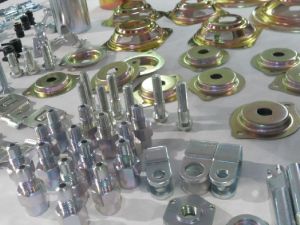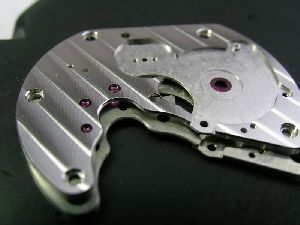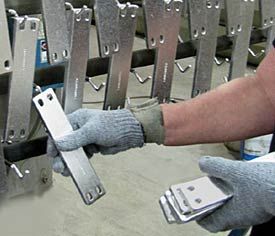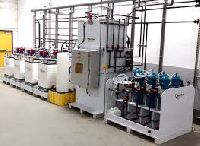
Zinc Plating
Zinc plating involves the electrolytic application of zinc by immersing clean steel parts in a zinc salt solution and applying an electric current. We carry four different zinc plating products that are sure to fit your metal plating needs. They include: An Alkaline non-cyanide zinc plating, Bright Acid chloride zinc plating, Zinc-nickel alloy plating Cyanide zinc plating Our zinc plating process is suitable for rack or barrel plating and large volume batches. Acid Chloride Zinc A mixed ammonium/potassium chloride bright zinc plating process It produces brilliant, level and ductile deposits even on difficult substrates such as cast iron, heat treated and carbonitrited steel. The water soluble brightener goes into solution much more readily than a solvent based brightener. A bright chloride zinc plating solution.It has the same inherent advantages and benefits as but uses a different carrier component. SMF is an expert metal finishing and metal plating company, and is also a member of ASTM International. For more information about ASTM International, click here. It is a thoroughly tested, stable and production proven zinc plating brightener process. It provides better zinc metal distribution than traditional alkaline zinc or chloride zinc plating systems. Operating parameters are wide and therefore it is an easy process to maintain. The process was developed to replace cyanide zinc plating without sacrificing the quality of the zinc deposit. Waste treatment is simplified and requires only a simple pH adjustment to precipitate zinc metal as zinc hydroxide. Benefits of Alkaline Zinc Plating: Totally eco friendly and does not contain cyanides at all. The deposits from Alkaline Zinc have better uniformity and metal distribution. there by improved corrosion resistance. No corrosive fumes. Eliminates the use of poisonous Cyanide and also reduces the cost of waste treatment to destroy Cyanides. Low current density coverage is excellent. Conventional plating equipments required for Cyanide Zinc plating can be used. No need for additional expenses. Chromate acceptance ability is superior to Acid Chloride zinc Process.
...more
Tin Plating
Color is gray white in plated condition, had very high luster in fused condition. Soft, but is very ductile. Corrosion resistance is good. (Coated items should meet 24 hour 5% salt spray requirement.) Solder ability is excellent. Tin is not good for low temperature applications (changes structure and loses adhesion when exposed to temperatures below -40 degrees C). If a bright finish is desired to be used in lieu of fused tin, specify Bright Tin plate. Thickness can exceed that of fused tin and in deposit shows excellent corrosion resistance and solder ability. Type I: Electrodeposited Type II: Hot dipped
...more
Silver Plating
Silver plating offers the highest electrical conductivity of all metals. It is not a precious metal and will oxidize rapidly. Silver plating is best suited for engineering purposes for solderable surfaces, electrical contact characteristics, high electrical and thermal conductivity, thermocompression bonding, wear resistance of load-bearing surfaces, and spectral reflectivity electrical applications, good corrosion resistance, good solderability, and other applications. Silver Plating Specification : Specification: Mil-QQ-S-365 Silver Plating, Electrodeposited Type I Silver Plating - Matte Type II Silver Plating - Semi-Bright Type III Silver Plating - Bright Silver Plating - Grades : With supplementary tarnish-resistant treatment. Without supplementary tarnish-resistant treatment Silver Plating - Tarnish-Resistance : Several options are available as supplementary coating for increasing tarnish resistance. Depending on solderability, or subsequent finishing steps such as painting or powder coating, we will recommend specific tarnish resistant coatings.
...more
Rhodium Plating Machine
Rhodium is white in color and is a precious metal, meaning non-oxidizing. Rhodium is a member of the Platinum Group of Metals. The Platinum Group of Metals is a group of six metals which include platinum, rhodium, palladium ruthenium, osmium, and iridium. These six metals all share some common physical properties. They have high melting points, are very dense, are very hard, and are very resistant to corrosion. Rhodium is the hardest of the PGM’s. Its’ hardness is about 800. Compare that to cobalt hardened gold at 200 knoop,14k ElectricGold at 400 knoop and at 400 knoop. Rhodium is the hardest, most wear resistant metal that we plate at Professional Plating. In addition to its’ hardness, rhodium is extremely resistant to corrosion. Rhodium is an excellent choice where contact with corrosive gases or other high corrosion environments will be encountered. Remember also that as the operating environment temperature increases, the corrosion rate will also increase. So in high temperature applications, rhodium will provide a longer life cycle, than, for example, gold will. Rhodium will reliably operate beyond 1000F. Rhodium is an extremely bright white metal. It is much whiter than palladium and platinum. For this reason and because of its’ extreme hardness, rhodium is very commonly used as an electroplated surface for fine jewelry. Rhodium plated product is well suited for such applications as sliding electrical contacts that require protection from sliding contact wear or galling. Also, because of its’ high temperature tolerance to oxidation, rhodium is an extremely good choice for high voltage/high amperage electrical contacts where contact arcing would otherwise cause the formation of highly electrically resistive oxide formations on the contact surface. The relevant specifications for calling out rhodium plating are =MIL-R-46085 Rhodium Plating, Electrodeposited, and ASTM B 634 – 88 (Reapproved 1999) Standard Specification for Electrodespoitied Coatings of Rhodium for Engineering Use We have two suggestions for specifying the plating of rhodium: 1. Thickeness of the deposit should be minimized. Electroplated rhodium deposits tend to develop a highly fractured, very dense crystal structure. This high fracture crystal structure contributes directly to the wear hardness and durability of the rhodium surface. However, as the thickness of the deposit increases the possibility of the electrodeposit fracturing and delaminating from the substrate increases. Standard good manufacturing practice for rhodium plating requires that the rhodium bath be kept absolutely free of impurities and continuously monitored for the correct amount of organic stress reduction compounds. When properly maintained, a rhodium electrodeposit of up to 100 micro inches (2.5 micros, 0.000100 inches) is regularly attained. A typical rhodium thickness would be 20 -30 micro inches. Please call us regarding your specific requirement. 2. It is our standard practice to undercoat all rhodium plating with a thin layer of gold. We strongly suggest that a thin gold upder-layer be included in the plating specification. Typically, plating specifications require only a nickel underplate for performance. However, the gold under-layer, in conjunction with proper bath maintenance will provide the most stress free, dependable electrodeposit.
...more
nickle plating
Similar to stainless steel in color, Plates uniformly in recesses and cavities (does not build up on edges). Corrosion resistance is good for coatings over .001 thicknesses. Electro less Nickel is used extensively in salvage of miss-machined parts. Also for inside dimensions and irregular shapes (where assembly tolerances need uniformity provided by Electro less process). Class 2 Baking Schedule to Achieve Hardness Class 1 As coated. Class 2 Steel, copper, nickel, cobalt-titanium based alloys and any basis metal not adversely affected by heating as specified. Class 3 Aluminum alloys non-heat-treatable, and beryllium alloys processedto improve adhesion of nickel deposit. Class 4 Aluminum alloy, heat-treatable, processed to improve adhesion of the nickel deposit. Grade A .001” Min. thickness Grade B .0005” Min. thickness Grade C .0015” Min. thickness (for severe corrosion protection).
...more
lead plating
Suresh metal Finishers Company provides industry-leading precision lead plating services to MIL-L-13808. Our expertise in providing technical barrel, rack and vibratory lead plating process is currently employed in numerous industries including the defense, railway, aerospace, bearing, fire-protection and battery sectors.Suresh metal Finishers lead plating services are employed for highly corrosive applications due to the outstanding performance of lead in corrosive environments especially when dealing with strong mineral acids such as sulfuric acid. Lead also has outstanding solderability making it ideal for use in critical electrical and electronic applications. Suresh metal Finishers also specializes in demanding plate-to-gauge lead plating services for bearing applications in the defense, aerospace and railway industries. Our dedicated Quality Control department provides prelate, in-process and post-plate dimensional and RMS inspections of inner and outer bearing surfaces to ensure dimensional and surface finish requirements are met. Heavy build lead plating services have been provided up to 0.020 inches in thickness per side. Lead Plating Services – Lead Properties Lead is an extremely soft, malleable metal that has the highest atomic number of all the stable elements. When freshly abraded lead can have a bluish-white color but it readily oxidizes to a dull gray color when exposed to oxygen-bearing environments. It is this thin oxide layer that protects the basis lead from further oxidation and lends it’s extreme resistance to hydrochloric and sulfuric acids. lends it’s extreme resistance to hydrochloric and sulfuric acids. Historic use of lead dates back to over eight thousand years ago due to its widespread availability and ease of extraction from its ore found in the earth’s surface. The Romans used lead extensively in plumbing due to its formability and corrosion resistance. Its elemental symbol, Pb, comes from its Latin name plumbum. Its early use in waterways is where the English word “plumber” finds its origin. Lead plating is a functional finish that provides a dull gray and slightly mottled deposit. Due to the matte nature of the deposits they are susceptible to rinsing stains and discoloration from handling. If a bright and uniform appearance is desired, the lead surface can be overplated with a thin coating of bright tin or the deposit can be subsequently reflowed to a bright appearance. Lead plating services on bearings are commonly used for break-in purposes on highly loaded bearing applications generally in the range of 3,000 to 8,000 PSI where the surface speed is relatively low. Heavier coatings are used in loadings up to 3,000 PSI where the thicker coating allows for imbedability of contaminants especially on grooved bearing designs. Lead Plating Services – Lead Specifications The most common lead plating service certified by Suresh metal Finishers is MIL-L-13808. Suresh metal Finishers also can certify lead plating services to most company-specific lead plating specifications. A summary of lead plating services Per MIL-L-13808 is provided below: Lead Plating Services to MIL-L-13808Type I: Without a preliminary copper coatingType II: With a 0.33um (0.000015 inch) minimum preliminary copper underplateClass 1 – 25 um (0.001 inch) minimum lead plating thicknessClass 2 – 13um (0.0005 inch) minimum lead plating thicknessClass 3 – 6 um (0.00025 inch) minimum lead plating thickness Additional information noted regarding lead plating types: 6.1.1 Type I – No Copper Underplate: Lead may be plated directly on copper, brass or copper rich alloy surfaces. For steel surfaces, the type II process with a preliminary copper coating should be used to obtain adequate adhesion and corrosion resistance. 6.1.2. Type II – Copper Underplate: Recommended for all applications except where the presence of the initial thin copper coating is detrimental to the use. The thin undercoat of copper increases the salt spray resistance of lead coatings varying in thickness from 6 to 25 um (0.00025 to 0.001 inch) by as much as a factor of two as well as improving adhesion of the lead to the steel.Lead Plating Services – Why Suresh metal Finishers? Suresh metal Finishers provides expertise in lead plating services to fulfill even the most demanding functional requirement. From prototyping and PPAP qualification to full production processing – it is dedicated effort to exceed your expectations. The following points highlight why Suresh metal Finishers is a leader in lead plating services:Diversity of Substrates: Suresh metal Finishers provides lead plating services on nearly any metallic substrate including hardened and alloyed steels, stainless steels, cooper and copper alloys including beryllium, chromium and tellurium copper, brass alloys, Inconels, Hastalloys, Monels, ductile & cast iron.Demanding Plate-to-Gauge Requirements: Suresh metal Finishers specializes in demanding plate-to-gauge lead plating services required for bearing applications. Our QC department is proficient in OD and ID bore micrometers and profilometer inspection to ensure bearings meet print dimensional and RMS requirements. REACH Compliance: Suresh metal Finishers is at the forefront of environmental compliance and can certify our lead plating services as needed to the current REACH regulations.Competitive Pricing: Suresh metal Finishers has been providing quality lead plating services for over twenty years. Competitive pricing in lead plating services is paramount to gaining and maintaining our customers in today’s competitive global marketplace. Lean Lead Times: With inventory a word of the past, rapid turn around is a key principle that we focus upon to provide the service our customers need.Value Added: Suresh metal Finishers prides itself on meeting the customer’s needs. Whether it’s custom engineering packaging, vacuum or nitrogen sealed packaging to enhance storage, Kanban inventory management, light subassembly or multiple finishing combinations – Suresh metal Finishers will work with you to ensure we meeting your needs in lead plating services.Extensive in House Analytical and Quality Lab Services: SPC is employed in all wet-lab work surrounding our lead plating services to ensure baths are analyzed and adjusted at optimum frequencies to ensure operation between critical upper and lower control points. Our quality lab employs the latest in x-ray, coulometric and spectrophotometer technologies to inspect your parts and will work to your requirements to provide testing as needed. Our quality lab can certify salt spray performance to ASTM B117, adhesion to ASTM B571 and solderability to ASTM B678. Mounted cross sections of parts are also available.
...more
Electroless Nickel Plating
Similar to stainless steel in color, Plates uniformly in recesses and cavities (does not build up on edges). Corrosion resistance is good for coatings over .001 thicknesses. Electro less Nickel is used extensively in salvage of miss-machined parts. Also for inside dimensions and irregular shapes (where assembly tolerances need uniformity provided by Electro less process).
...more
Electroless Gold Plating
Electroless means that the process used to plate the gold onto a surface is not the traditional electroplating cell having electrodes and an external power supply. Electroless gold is deposited from a solution purely as the result of the reaction of chemicals in the bath. The electroless plating bath is comprised of several of the same items found in an electrolytic gold plating bath, but it also includes chemicals (reducing agents) to provide electrons for the reaction and other chemicals (chelating agents and stabilizers) to control the reaction so that it can be predictable and controllable as a manufacturing process. Why Does It Matter Which Process is Used to Plate?Is the Deposit the Same?To plate a part using an electrolytic process, every surface to be plated must be connected electrically so that it can act as the cathode in the plating cell. This becomes difficult for many products but especially for electronic circuits that generally need to have electrically isolated surfaces to be functional. Over the course of the development of the electronics industry it has become common practice to design in connections to tie different surface metal patterns together just for plating and then to remove these connections after plating. The manufacturing inefficiencies of this are obvious but a greater problem is the restriction this places on the final performance and circuit density of the component. Using electroless gold plating, circuits can be designed and fabricated in their final configuration. This saves the manufacturer several steps but more importantly it allows the circuit design to place primary consideration on optimum circuit performance and minimum circuit size. The electroless gold deposit is identical to an electrolytic pure gold deposit (i.e., Mil-G-45204 C Type III or ASTM B488 Type 1 hardness code A) in essentially every way; thickness, purity, hardness, grain size, density and color. The primary difference from an electrolytic gold deposit is it's second distinct advantage... improved thickness distribution. Electrolytic plating creates deposits that have thickness variations resulting primarily from the shape of the electrical field between the cathode surfaces and the anode. These deposits are thicker on corners and edges and surfaces where the distance to the anode is shortest. They are also thinner in the middle of surfaces, inside of holes and on surfaces facing away from the anode. Electroless plating completely eliminates this source of variation. Electroless gold plated deposits are uniform in thickness around corners, on both sides of a part, even on the inside walls of small holes that may be very deep.
...more
cadmium plating
This specification covers the requirements for electrodeposited cadmium coatings on products of iron, steel, and other metals. Cadmium coatings are used for corrosion resistance and corrosion prevention The as deposited coating (Type I) is useful for the lowest cost protection in a mild or noncorrosive environment where early formation of white corrosion products is not detrimental or harmful to the function of a component. The prime purpose of the supplementary chromate finishes (Types II and III) on the electroplated cadmium is to increase corrosion resistance.Electrodeposited cadmium coatings shall be classified on the basis of thickness as Class 25, 12, 8, and 5. The coating shall be essentially pure cadmium produced by electrodeposition usually from an alkaline cyanide solution. The basis metal shall be subjected to such cleaning procedures as necessary to ensure a surface satisfactory for subsequent electroplating. Cadmium shall be deposited directly on the basis metal part without an undercoat of another metal except when the part is either stainless steel or aluminum and its alloys. The plating shall be applied after all basis metal heat treatments and mechanical operations. The thickness of the coating everywhere on the significant surface shall conform to the requirements of the specified class. The cadmium coating shall be sufficiently adherent to the basis metal to pass the tests. The supplementary Type II chromate film shall be adherent, nonpowdery, and abrasion resistant. The thickness of electrodeposited cadmium coatings shall be determined by the applicable test methods.
...more
acid zinc plating
Zinc plating involves the electrolytic application of zinc by immersing clean steel parts in a zinc salt solution and applying an electric current. We carry four different zinc plating products that are sure to fit your metal plating needs. They include: An Alkaline non-cyanide zinc plating, Bright Acid chloride zinc plating, Zinc-nickel alloy plating Cyanide zinc plating Our zinc plating process is suitable for rack or barrel plating and large volume batches.
...more
Chromate Conversion Coating

anodizing

cadmium plating services

Hard Anodizing

Trivalent Chromium Passivation

Phosphating Services

manganese phosphating services

Gold Plating Electroless

Nickel Plating
Nickel can be deposited soft or hard-dull or bright, depending on process used and conditions employed in plating. Thus, hardness can range from 150–500 Vickers. Can be similar to stainless steel in color, or can be dull gray or light gray (almost white) color. Corrosion resistance is a function of thickness.Class 1A: For corrosion protection Grade A: .0016” Min. thickness Grade B: .0012” Min. thickness Grade C: .0010” Min. thickness Grade D: .0008” Min. thickness Grade E: .0006” Min. thickness Grade F: .0004” Min. thickness Grade G: .0002” Min. thickness Class 2: For engineering applications Electro less Nickel plating, Nickel is generally used as a semi-bright white corrosion resistant finish. Electro less nickel plates with unusually uniform dimensional build up on parts so that you don’t get thick regions at outside corners and thin regions at inside corners and in cavities. Also, E-Nickel is hard and offers good wear resistance. The corrosion resistance improves with increasing phosphorous content. We offer both mid-phosphorus and high-phosphorus E-Nickel solutions. E-Nickel (Plating is) plates very well to many types of aluminum and therefore serves as an excellent base for precious metals, which generally don’t adhere well to aluminum. Mil Spec C–26074
...more
gold plating
Gold is unique with its yellow color. Also, gold is a precious metal, which means that it will not oxidize in air, so its electrical conductivity stays uniform over long periods of time. It is ideally suited for gold electroplating applications. Gold plating offers good corrosion resistance, good solderability, and when alloyed with cobalt, it has very good wear resistance. Gold is commonly used in electrical switch contacts, connector pins and barrels, and other applications where intermittent electrical contact occurs.\ Specification: MIL-G-45204 Gold Plating, Electrodeposited Type I 99.7 % gold minimum; hardness grade A, B, or C. Gold plating used for general-purpose, high-reliability electrical contacts, solderability, and wire wrap connections. Type II 99.0 % gold minimum; hardness grade B, C, or D. A general-purpose, wear-resistant gold. It will not withstand high-temperature applications because the hardening agents in the gold plating will oxidize. Type III 99.9 % gold minimum; hardness grade A only. Gold plating for semiconductor components, nuclear engineering, thermocompression bonding, and high-temperature application. Gold Plating & Gold Electroplating - purity and coating thickness: Co-deposited impurities can make soldering more difficult, and for this reason high purity gold plating is preferred. Soldering requirements are best achieved when gold electroplating coatings range between 0.00005 and 0.0001 inch (50 and 100 micro inches) thickness. Gold Plating & Gold Electroplating - Hardness Grades: A. 90 knoop, maximumB. 91-129 knoop, inclusiveC. 130-200 knoop, inclusiveD. 201 knoop, minimum Specification: ASTM B 488 Standard Specification for ElectrodepositedCoatings of Gold for Engineering UsesType-I 99.7% gold minimum; hardness grade A, B, or C *Type-II 99.0% gold minimum; hardness grade B, C, or D *Type-III 99.9 % gold minimum; hardness grade A only * Specification: AMS 2422 Gold Plating for Electronic and Electrical Applications An underplate of copper (from a copper cyanide solution) is required unless the base material is copper or a copper alloy containing less that 15% zinc.Copper Thickness: Not less than 0.0001" A layer of nickel (from a Watt's or chloride solution) is required over the copper underplate or copper base material.Nickel Thickness: Not less than 0.0001" The gold (from a cyanide solution) is to be deposited directly on the nickel layer.Gold Thickness: Not less than 0.00005" on all functional surfaces. Gold Purity: Not less than 99.0% pure. About solderability: MIL-G-45204 extract: Codeposited impurities can make soldering more difficult, and for this reason high purity gold coatings should be used for those applications. Excellent solderability is best achieved when the gold thickness is between 0.00005 and 0.0001 inch. About Undercoating: MIL-G-45204 extract: a) Unless otherwise specified, gold over silver underplate combinations should be excluded from electronics hardware (3.4).b) When gold is applied to a copper rich surface such as brass, bronze, or beryllium copper, an antidiffusion underplate such as nickel should also be applied (3.4). Gold over silver is not recommended for electronics hardware: Gold Plating - Underplate Recommendations Gold Electroplating - When gold is applied to a copper rich surface such as brass, bronze, or beryllium copper, metal ions from these base metals will diffuse into the gold layer and degrade its hardness and non-oxidizing properties. An antidiffusion underplate such as nickel (electroless or sulfamate) should be applied to prevent this. We recommend electroless nickel under gold where part flexure of deformation is not expected and a bight finish is desirable. Where part flexure or deformation is expected, we recommend sulfamate nickel as the underplate because of its higher ducility.
...more
Gold Plating Barrel Process

Chromate Conversion Coatings
Be first to Rate
Rate This